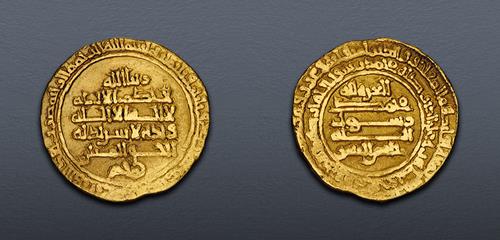
|
Fatimids. Abu Yazid al-Nukkari. Rebel, AH 332-336 / AD 943-947. AV Dinar (18.2mm, 4.15 g, 12h). Al-Qayrawan mint. Dated AH 333 (AD 944/5). Near VF.
Islamic Auction 4 – Session 1
Lot: 120. Estimated: $ 5 000
Fatimids, Gold
Sold For $ 5 000. This amount does not include the buyer’s fee.
Go to Live
|
|
Fatimids. Abu Yazid al-Nukkari. Rebel, AH 332-336 / AD 943-947. AV Dinar (18.2mm, 4.15 g, 12h). Al-Qayrawan mint. Dated AH 333 (AD 944/5). Obverse field: rabbuna Allah / la hukm illa lillah / la ilaha illa Allah / wahdahu la sharik lahu / al-haqq al-mubin / Reverse field: al-‘izza lillah / Muhammad / rasul / Allah / khatam al-nabiyyin. Nicol 201. Minor weakness. Near VF. Very rare.
Abu Yazid Makhlad was born circa AH 270 and grew up in Tuzir (Byzantine Tusuros) in south-west Tunisia. As a young man he moved to Tahirt, the capital of the local Rustamid dynasty and the spiritual centre of the Ibadi movement. Abu Yazid himself became a leader of the Nukkari sect and so after the Rustamids were overthrown by the Fatimid partisan Abu ‘Abdallah al-Shi‘i in AH 296 Abu Yazid’s hatred of the Fatimids was fuelled by his personal experience as well as religious disagreement.
After the fall of the Rustamids, Abu Yazid spent more than a decade fomenting anti-Fatimid feeling. By AH 322, when the Fatimid al-Mahdi died, Abu Yazid was the leader of a confederation of local tribes, working to form a broad coalition to oppose Fatimid rule. After a brief spell in prison, in AH 332 he was at last able to rouse the local tribes into launching an all-out assault on the Fatimids. At an early stage of this campaign someone brought him a grey donkey to ride, and the image of this old man, simply dressed and riding a donkey, had a powerful effect in convincing his supporters of his righteousness and determination.
Several towns soon fell to Abu Yazid and his army. Baja, which resisted, was sacked and burned but Tunis, which surrendered, was spared. Qayrawan itself fell in AH 333 and Abu Yazid allowed his Berber troops to pillage the city, remarking that even Jerusalem and Makka had suffered destruction in the past. The future of the Fatimid caliphate hung in the balance as Abu Yazid marched onwards to Mahdiya which he besieged in AH 334, with the caliph al-Qa’im trapped inside. But the city held out, and Abu Yazid’s supporters proved to have little appetite for a protracted siege. Finally, al-Qa’im was able to break out through and launch an assault on the rebel's waning forces. Abu Yazid fled, and while al-Qa’im himself died during the siege his successor, Isma‘il al-Mansur, launched a vigorous counter-attack. Abu Yazid withdrew to Qayrawan, but the cititzens now resented him for the brutality of his Berber troops and he found the gates closed against him. With his remaining followers he fled into the mountains, but the Fatimid forces pursued him and managed to capture the hilltop fortress where Abu Yazid had taken refuge. It seems that the rebel himself nearly contrived to escape in the darkness, but was captured after he fell into a ravine while trying to flee. He died of his wounds four days later, probably in Muharram of AH 336.
The final winners of all CNG Islamic Auction 4 – Session 1 lots will be determined during the live sale that will be held on 19 October 2023.
Winning bids are subject to a 22.5% buyer's fee for bids placed on this website and 25% for all others.
We recognize that our users may have various Internet Browsers and Operating Systems. We like our visitors to have the best possible experience when using our bidding platform. However, we do recognize that it is impossible to develop applications that work identically, efficiently and effectively on all web browsers. The CNG bidding platform supports the latest stable major version and stable previous version of Chrome and Firefox.
|
